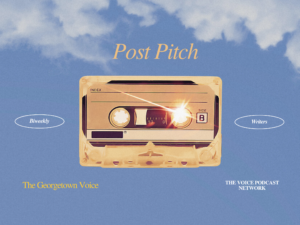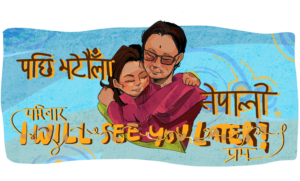Content warning: This essay discusses suicide.
Suicide and Crisis Lifeline: Dial 988 if you are in crisis or looking to help someone in crisis.
Visit 988lifeline.org for more information and resources.
There’s a voicemail I will never delete. “Please call me back whenever you get the chance, thank you.” Seeing who left it made my heart drop. I had her phone number saved, but we had never chatted one-on-one.
I called her back from the gritty stairwell of my friend’s Henle. Some part of me knew what she was going to say.
She told me that her older brother––my friend––passed away the night before.
I remember her voice when I asked her how he died—somber, collected, heavy. I wanted to tell her how sorry I was, to offer my condolences to her parents, but I could not keep myself together. My heart cracked for her as I processed that she was calling me, and all of his friends, to tell us that M. died by suicide the night before.
We hung up in under five minutes.
…
My high school friends and I went shopping for denim jackets ahead of his memorial service. They were M.’s signature fashion choice. We wore what he used to wear every day of high school. It was a way of showing up for each other. Together, we arrived at his service and listened to stories about his life.
My garage—with its greasy tools, fully stocked fridge, and occasional cockroach companions—was a palace for our late nights watching bad movies until someone fell asleep (usually me). We compared the color grading of the Fifty Shades of Grey (2015) films to their predecessors in Twilight (2008). We played cup pong with lemonade until E. had acid reflux. We did these things together—we tried to say goodbye together, too.
Grieving someone who died by suicide is specific. M. did not die from an accident or old age, he was not in poor physical health. He did this. He felt like this was the only thing he could do.
I tried not to talk about M. with my friends at Georgetown when I got back two days after his burial. Saying anything more than “no, I’m not fine” felt too awful to put onto others. My high school friends stopped talking about M., too. We kept our texts and conversations lighthearted, unmoored by loss even as it marred everything within reach. I stopped showing how sad I was all the time. I started to grieve alone.
…
I carry so much anger, guilt, and blame over his death. I scream so many questions into my head.
Why did M. feel this way? Why couldn’t he find help? Why did he not see a way out? Did he think about how this would impact everyone who loved him so desperately? Did he know how much we loved him? Why didn’t I do more? What would have happened if I texted him that same Monday he died by suicide?
Why did M. die?
None have a remotely comforting answer—and M., of course, isn’t around to give one. I read that one day I should try to stop asking them, and that I should let go of blame. But isn’t blame important? Doesn’t blame mean accountability for his death? Aren’t we all accountable?
Grief is a solitary experience on some level—it’s personal, intimate. But people can still grieve collectively. Placing grief in a community context elicits solidarity and a stronger ethics of interpersonal care. It helps unmask the shame, guilt, and blame that surround suicide. It names these questions, so at the very least, one knows other people are asking the same things, too. Discussing grief openly won’t diminish the loss, but maybe it can make the pain less hollow—less lonely.
There are barriers to collective grief: maintaining community is heartbreaking when a member of that community is no longer here. It’s difficult to carve out bandwidth for sharing trauma through words. For many, it’s impossible to take time off from work or school to process grief. Spaces for sharing this acute pain can feel rare or hard-earned. Exporting emotional trauma onto close friends feels burdensome. Therapy is expensive and inaccessible. But this environment that prevents collective grief reflects the same conditions that allow suicide to occur.
Globally, more than 700,000 die from suicide each year, and many more attempt it. Suicide is the second leading cause of death for people ages 20-34. Queer people are four times more likely to attempt suicide. Systems, cultures, and circumstances create conditions that make people view suicide as their only escape. Race, gender, socioeconomic status, sexual orientation, and more collide to mediate how people access care.
Despite the increase in death by suicide, there remains a pervasive stigma around mental health struggle and an absence of environments for emotional support. Coupled with this, the social expectation to get over something—or act like you are—makes grief more damaging and lonely than it should be. Timelines for grief are irregular, but few make choices to actively recognize that reality interpersonally, professionally, and academically. Social withdrawal and a lack of energy require justification—and disclosing loss like this feels too serious. Within Georgetown’s academic environments, we can’t be debilitatingly sad for more than a couple of weeks—missing more than that requires a leave of absence. Changing this culture around grief shapes other systems: if we can be open about grief, we can be open about mental illness.
I return to the question, “why did M. die?” and I have no answers. I know that this wasn’t meant to happen, that this could have been prevented.
E. asks a question over sushi on my 21st birthday: if you could go back in time and relive your entire life with the knowledge you have right now, would you? She says she would save M. This is the first time I hear us talk about M. as someone who died by suicide since his funeral. We would dance around that painful, obvious fact—reminiscing on his silliness, if we brought him up at all.
Maybe I’m not alone in this, I think, as I pour a round of hot sake. We toast to 21 years. I think of my friend who is missing. They think about him, too. We are all here, together. For the first time since he died, I smile, just a little, for M.





